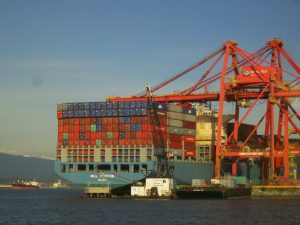Carriers Should Have Spent More to Make Ships Better Not Bigger

Picture: Ruth Hartnup
With the collapse of Hanjin Shipping, all eyes in the international shipping industry have turned their gaze on carriers. For years, carriers have struggled to be profitable, suffering huge losses.
One of the biggest factors that make profitability difficult for shipping lines to achieve is downward pressure on freight rates. Freight rates are simply too low for carriers to make a profit against their cost margins.
The previous blog refutes the idea that shippers share the blame for this downward freight rate pressure that has played such a huge role in carriers losing money and Hanjin going bankrupt.
Overcapacity, where there is much more container ship space than cargo to fill it, is the largest factor in pushing freight rates down. It’s basic supply and demand. You can read in that last blog how investing so heavily in megaships, dramatically increasing overcapacity and downward pressure on freight rates, was a big mistake carriers made.
Rather than spend this blog rehashing why investing in bigger and bigger ships was a bad decision by carriers, let’s look at where the shipping lines are beginning to invest that is actually a good idea. It’s a good idea that they should have been focused on instead of their megaship craze.
The Economist published an article called A.P. Moller-Maersk Profits Overboard. The article gets into the world’s largest carriers’ investment strategies. What stands out is the carriers’ shift from building bigger ships to making its ships “smarter” with digitization. Finally.
Maersk Group’s big new idea is to make its existing ships smarter. Mr Toft says Maersk Line will focus on using these ships better by embracing the “age of digitisation”. This is an area in which shipping lags well behind other sectors, such as aerospace. Whereas a modern jetliner creates several terabytes of data a day, it takes the average cargo ship 50 days to produce a single one. Most ships do not even have basic sensors to ensure their hatches are closed before leaving port. Until very recently the industry resisted using data properly, says Martin Stopford, president of Clarkson Research, part of a shipbroker. Now it cannot afford to ignore systems that offer the chance of reducing costs by up to 30% by better co-ordinating the interaction of ships and shore, he says.
The international shipping industry has long lagged behind technology. At the ports it can be somewhat understood, as unions have often fought against new technologies like automation for fear of the loss of jobs; however, it’s hard to understand why shipping lines have avoided new technologies that could benefit them a great deal.
Some might be presumptive and think it is intentional on the part of carriers in order to maintain the lack of transparency shipping lines enjoy. However, it is more likely caused by a lack of ingenuity in the culture of shipping lines, as an executive of one of Maersk’s rival carriers was quoted in the Economist article as saying, “We just watch what Maersk does and copy it.”
Luckily, carriers should soon be copying their way in the correct direction when it comes to technology, as the article describes Maersk’s shift to digitization:
Maersk Line is retrofitting its ships to collect more data. Last year it installed sensors on its containers that track their location and contents. That makes it easier for port terminals to handle them, so ships can leave and start earning money again more quickly. Software also works out how to stack containers on ships more efficiently.
…
The Danish firm’s three-year-old analytics team has also worked on discovering the optimal speed and course for its ships. They are trying to cut its big repair bills, too. The hope is that predictive maintenance could achieve this quickly. Instead of waiting for ship engines to break down, sensors will report when they need care.
Digitization passes a test carriers seemed to skip with their investments in megaships. A business should ask itself before moving forward with a strategy whether or not that strategy benefits the business’s consumers, partners, and industry as a whole. Even more importantly, does the strategy impact the business’s partners, consumers, or industry negatively?
Ideally, a business strategy should benefit the business, its partners, its consumers, and its industry as a whole.
Unlike the trend toward megaships, a trend toward better technology with digitization from carriers is good for the rest of the industry. Digitization should lead to increased transparency and better reliability in international shipping instead of the huge cost increases and congestion at ports that megaships caused.
Back in May, Martyn Wingrove wrote on Container Shipping and Trade:
Digitisation of vessels and fleets will be the main driver of innovation and business in shipping for the next 10 years, according to class society DNV GL. It predicts further deployment of sensors across fleets of ships, greater levels of remote internet connectivity and developments in data analytics in the future.
It’s good to see a trend from the carriers that could be so positive for the industry.
Just imagine if the billions of dollars carriers spent on building megaships instead went into new technologies for the ships they already had.
The result would have been less capacity, higher freight rates, and cost savings for shipping lines.





Again due respect, you are off base here. Keeping track of containers is NOT a vessel improvement. For every day on the water, containers are 12 days on land, and containers on vessels equal less than 20% of the carriers container fleet. So making sure of where every container on the ships are takes care of less than 20% of keeping track of customers freight.
The vessels of today are intimately “better” than those of ten years ago, even 6 years ago. Fuel consumption has almost be halved by technological advances in engines, and they are far cleaner burning than their counterparts.
Your argument on overcapacity is stating the obvious, except you forget 2010., In 2009 the industry lost $20. Billion due to a great drop in volume (nearly 18%) globally and the concomitant reduction in rates. The response was to anchor over 600 vessels and in doing so, stabilized the rates and eventually raising them and the industry made a profit of $8 Billion – and $28. Billion swing in one year through capacity management. They haven’t
repeated that business model since then and as an industry lost money every year since. But to your point, since 2010 while the industry lost Billions, Maersk Line made nearly $5 Billion. Why, a lot of small ships? Hardly, but better managing their assets and revenue many of which happen to be modern, technologically advanced large container ships deployed in the lengthy Asia/Europe markets.
I think the most important technological advancement this industry is the need for full visibility of container location. I believe the best way to achieve this is live tracking on the containers themself.
Thanks again, for commenting, Gary. Good points, as always.
Bringing up the carriers anchoring vessels furthers my point. Doing so, carriers decreased capacity. That made sense in controlling freight rates and decreasing downward pressure on rates. The megaship craze has increased capacity when they should have been controlling it with strategies like anchoring and scrapping vessels.
For Maersk, there was some sense creating bigger ships. They did so with thought and strategy (of course, even Maersk has not been without its struggles either). The rest of the carriers just seem to do whatever Maersk does whether it really makes sense for them or not.
Ships have gotten better in terms of fuel consumption and CO2 emissions because they were forced to by environmental regulations regarding pollution in the international shipping industry.
Cargo tracking is not my biggest focus on ship improvement (although, I do like that for more transparency from carriers, which is certainly lacking) but on things like predictive maintenance technology on ships which could save a lot of money for carriers rather than bigger ships that increase capacity and congestion while pushing freight rates lower.